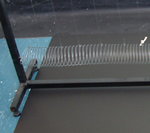Abstract

A slinky mounted on a frame is used to demonstrate transverse and longitudinal standing waves. Markers on the slinky make the oscillatory motion of the medium visible.
Videos
Transverse 2nd Harmonic
Download Videos: Right-click and “save as.”
Transverse Standing Waves
Fundamental.mv4 (178 KB) || 2nd-harmonic.m4v (555 KB)
3rd-harmonic.m4v (177 KB) || 4th-harmonic.m4v (405 KB)
Longitudinal (compressional) Standing Waves
Longistdgwave.m4v (411 KB)
Portable
Yes
Principles Illustrated
Transverse and longitudinal standing waves, oscillatory motion of the medium when transverse or longitudinal waves are present. Use the Slinky Pulses resource prior to using this one.
NCEA & Science Curriculum
PHYS 2.3
Instructions
Use the Slinky Pulses resource prior to using this one.
It’s not very difficult to build a similar apparatus. Contact us for help if you wish to do this.
Safety
Individual teachers are responsible for safety in their own classes. Even familiar demonstrations should be practised and safety-checked by individual teachers before they are used in a classroom.
Related Resources
- Slinky Pulses
- Wave Simulator software
- Wave simulator machine
Notes
These videos (or better yet the actual apparatus) can help illustrate longitudinal and transverse waves. Light is a transverse EM wave while sound is a longitudinal or compressional wave. It is helpful to show students how a speaker works after showing videos. Have them put their fingers on the speaker while playing a tone of perhaps 100 Hz. They can feel the motion of the speaker and will understand how it produces longitudinal (compressional) waves in air.
What about water waves? The surf in other words. Are these waves transverse or longitudinal? No they are not. They are surface waves on the boundary between two media. This is another kind of wave.
References
PIRA 3B22.50, 3B22.60
Teaching Resources
Would you like to contribute lesson suggestions? Contact us.
Credits
This teaching resource was developed with support from
The MacDiarmid Institute
Faculty of Science, Victoria University of Wellington
School of Chemical and Physical Sciences, Victoria University of Wellington